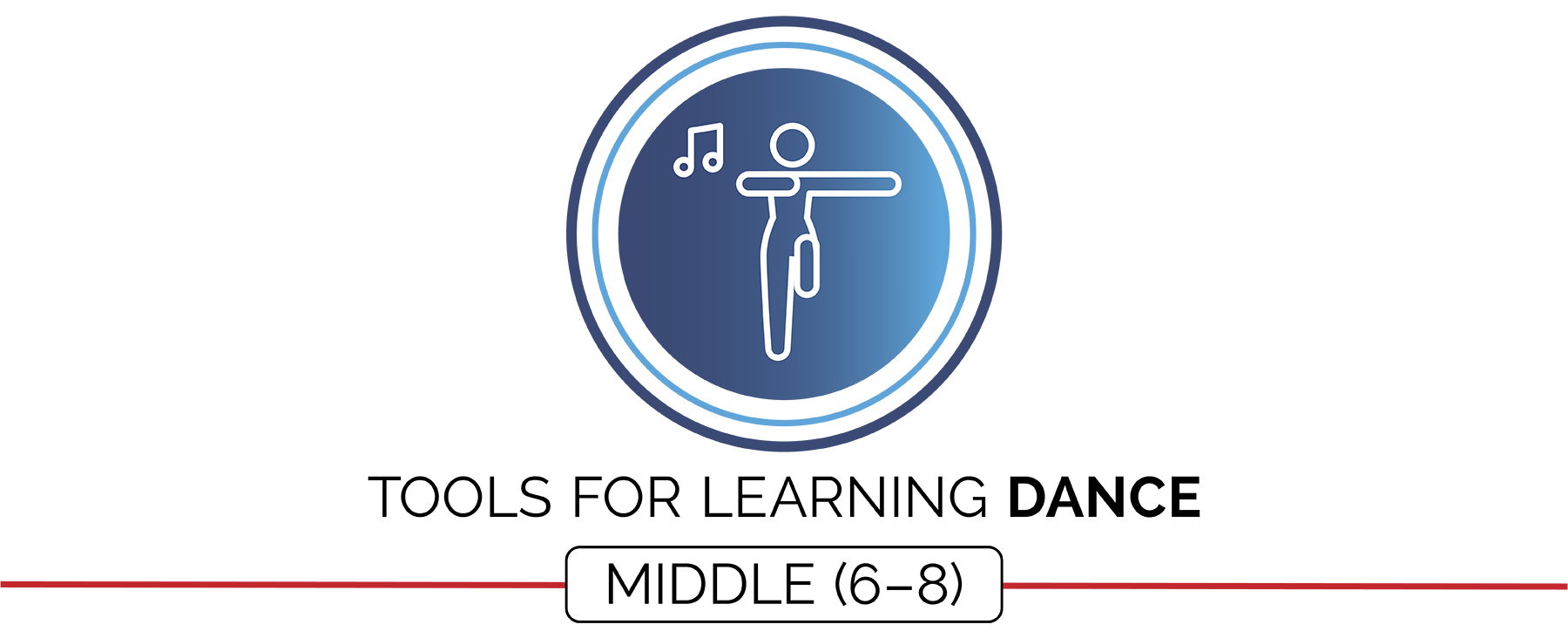Created by: Brandon Herwick, Rich Wiles, Dr. Theresa Cone, Pam Powers, Shannon Maly, Ben Pirillo, Scott Williams, Deedi Brown, Bob Oats, Chris Walker, Alex O’Brien, Matt Bristol, Matt Johnson
Special Contributions: Aaron Hart, Brian Devore & Tammy Hanna
Design: Jennifer Truong
This module builds upon the learning and enjoyment that students experienced in the OPEN dance modules for grades K-2 and 3-5. The dances and activities build in complexity and ask students to use social and emotional strategies to create a positive learning environment. In order to help your students progress through this module, keep the environment fun and silly, while also maintaining high expectations for learning.
Learning dance is ultimately a journey of self-expression. Perfecting every step is not what is important. Personal enjoyment, social engagement, and appreciation for all movement forms will ultimately keep dance as an important element of an individual’s physical literacy journey. Teach and reinforce skills and concepts while keeping the magic of movement alive.
Module Documents
Complete Module Packet:
Module Overview:
Required Materials:
All Module Activities:
Sample Lesson Plan:
Academic Language Cards:
Sports Picture Activity Cards:
Fist Pump Jump Jump (Card):
Samoa Sasa (Card): COMING SOON
Crazy Bird (Card):
D'hammerschmiedsgselln:
Appalachian Big Circle:
Dance with Words Movement Cards:
Universal Design Adaptations:
Activity Plans
The Safety Dance:
Sports Picture Dance:
Fist Pump Jump Jump:
Samoa Sasa:
Crazy Bird (Baba Hou!):
D'Hammerschmiedsgselln:
The Appalachian Big Circle:
Dance with Words:
Assessments
Holistic Performance Rubric:
Academic Language Quiz:
Dance w/Words Brainstorm Page:
Teacher Evaluation
Teacher Self-Evaluation/Reflection Guide:
Can’t see the file links? Register for FREE today to access all of the modules. SIGN UP HERE
National Standards and Outcomes Focus for the OPEN 8 Challenge
Standard 1.Demonstrates competency in a variety of motor skills and movement patterns.
- Standard 1 [M1.6-8] Demonstrates correct rhythm and pattern for one of the following dance forms: folk, social, creative, line, or world dance (6); Demonstrates correct rhythm and pattern for a different dance form from among folk, social, creative, line, and world dance (7); Exhibits command of rhythm and timing by creating a movement sequence to music as an individual or in a group (8).
Standard 2.Applies knowledge of concepts, principles, strategies and tactics related to movement and performance.
- Standard 2 [M1.6-8] Creates open space by using locomotor movements (e.g., running, jumping & landing) in combination with movement (e.g., varying pathways; change of speed, direction, or pace) (6); Reduces open space by using locomotor movements (e.g., walking, jumping & landing, changing size and shape of the body) in combination with movement concepts (e.g., reducing the angle in the space, reducing distance between player and goal) (7); Opens and closes space during small-sided game play by combining locomotor movements with movement concepts (8).
- Standard 2 [M12.6-8] Varies application of force during dance or gymnastic activities (6); Identifies and applies Newton’s laws of motion to various dance or movement activities (7); Describes and applies mechanical advantage(s) for a variety of movement patterns (8).
Standard 3.Demonstrates the knowledge and skills to achieve and maintain a health-enhancing level of physical activity and fitness.
- Standard 3 [M6.6-8] Participates in moderate to vigorous aerobic physical activity that includes intermittent or continuous aerobic physical activity of both moderate and vigorous intensity for at least 60 minutes per day (6); Participates in moderate to vigorous muscle- and bone-strengthening physical activity at least three times a week (7); Participates in moderate to vigorous aerobic and/or muscle- and bone strengthening physical activity for at least 60 min/day at least five times a week (8).
- Standard 3 [M14.6-8] Identifies major muscles used in selected physical activities (6); Describes how muscles pull on bones to create movement in pairs by relaxing and contracting (7); Explains how body systems interact with one another (e.g., blood transports nutrients from the digestive system, oxygen from the respiratory system) during physical activity (8).
Standard 4. Exhibits responsible personal and social behavior that respects self and others.
- Standard 4 [M1.6-8] Exhibits personal responsibility by using appropriate etiquette, demonstrating respect for facilities, and exhibiting safe behaviors (6); Exhibits responsible social behaviors by cooperating with classmates, demonstrating inclusive behaviors, and supporting classmates (7); Accepts responsibility for improving one’s own levels of physical activity and fitness (8).
- Standard 4 [M4.6-8] Accepts differences among classmates in physical development, maturation, and varying skill levels by providing encouragement and positive feedback (6); Demonstrates cooperation skills by establishing rules and guidelines for resolving conflicts (7); Responds appropriately to participants’ ethical and unethical behavior during physical activity by using rules and guidelines for resolving conflicts (8).
- Standard 4 [M6.6-8] Identifies the rules and etiquette for physical activities/games and dance activities (6); Demonstrates knowledge of rules/etiquette by self-officiating modified physical activities/games or following parameters to create or modify a dance (7); Applies rules/etiquette by acting as an official for modified physical activities/games & creating dance routines within a given set of parameters (8).
- Standard 4 [M7.6-8] Uses physical activity and fitness equipment appropriately and safely, with the teacher’s guidance (6); Independently uses physical activity and exercise equipment appropriately and safely (7); Independently uses physical activity and fitness equipment appropriately and identifies specific safety concerns associated with the activity (8).
Standard 5. Recognizes the value of physical activity for health, enjoyment, challenge, self-expression, and/or social interaction.
- Standard 5 [M3.6-8] Recognizes individual challenges and copes in a positive way, such as extending effort, asking for help/feedback, and/or modifying the tasks (6); Generates positive strategies such as offering suggestions/assistance, leading/following others, and/or providing possible solutions when faced with a group challenge (7); Develops a plan of action and makes appropriate decisions based on that plan when faced with an individual challenge (8).

